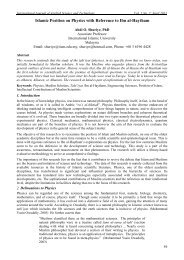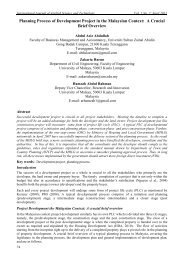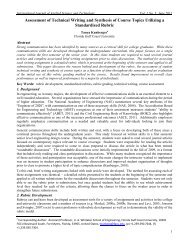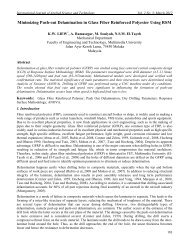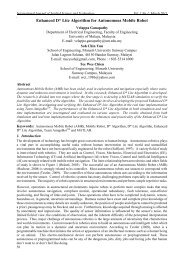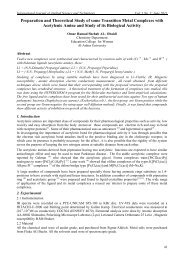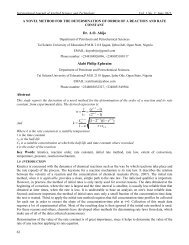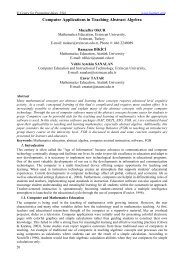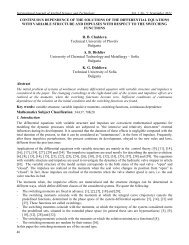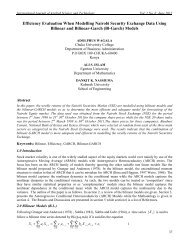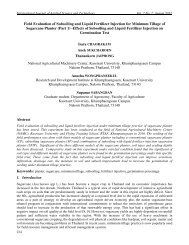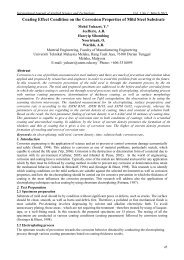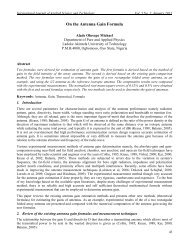Effect of Curing Methods on Density and Compressive Strength of ...
Effect of Curing Methods on Density and Compressive Strength of ...
Effect of Curing Methods on Density and Compressive Strength of ...
You also want an ePaper? Increase the reach of your titles
YUMPU automatically turns print PDFs into web optimized ePapers that Google loves.
© Center for Promoting Ideas, USA www.ijastnet.com<br />
If c<strong>on</strong>crete is cured for <strong>on</strong>ly three days, it will reach about 60% <str<strong>on</strong>g>of</str<strong>on</strong>g> the strength <str<strong>on</strong>g>of</str<strong>on</strong>g> c<strong>on</strong>tinuously cured c<strong>on</strong>crete; if<br />
it is cured for seven days, it will reach 80% <str<strong>on</strong>g>of</str<strong>on</strong>g> the strength <str<strong>on</strong>g>of</str<strong>on</strong>g> c<strong>on</strong>tinuously cured c<strong>on</strong>crete. If curing stops for<br />
some time <strong>and</strong> then resumes again, the strength gain will also stop <strong>and</strong> reactivate (Mamlouk <strong>and</strong> Zaniewski,<br />
2006). If a c<strong>on</strong>crete is not well cured, particularly at the early age, it will not gain the required properties at<br />
desired level due to a lower degree <str<strong>on</strong>g>of</str<strong>on</strong>g> hydrati<strong>on</strong>, <strong>and</strong> would suffer from irreparable loss (Ramezanianpour <strong>and</strong><br />
Malhotra, 1995; Zain et al., 2000). Improper curing would entail insufficient moisture <strong>and</strong> this has been found to<br />
produce cracks, compromise strength, <strong>and</strong> reduce l<strong>on</strong>g-term durability (Wojcik <strong>and</strong> Fitzgarrald, 2001).<br />
It is a known fact that many other factors affect the development <str<strong>on</strong>g>of</str<strong>on</strong>g> strength <str<strong>on</strong>g>of</str<strong>on</strong>g> c<strong>on</strong>crete <strong>and</strong> c<strong>on</strong>sequently its<br />
durability other than curing or the curing technique applied. These factors include quality <strong>and</strong> quantity <str<strong>on</strong>g>of</str<strong>on</strong>g> cement<br />
used in a mix, grading <str<strong>on</strong>g>of</str<strong>on</strong>g> aggregates, maximum nominal size, shape <strong>and</strong> surface texture <str<strong>on</strong>g>of</str<strong>on</strong>g> aggregate (Arum <strong>and</strong><br />
Alhassan, 2005) water/cement ratios, degree <str<strong>on</strong>g>of</str<strong>on</strong>g> compacti<strong>on</strong> (Aluko, 2005) <strong>and</strong> the presence or otherwise <str<strong>on</strong>g>of</str<strong>on</strong>g> clayey<br />
particles <strong>and</strong> organic matter in the mix (Arum <strong>and</strong> Udoh, 2005). The scope <str<strong>on</strong>g>of</str<strong>on</strong>g> discussi<strong>on</strong> in this study is methods<br />
<str<strong>on</strong>g>of</str<strong>on</strong>g> curing c<strong>on</strong>crete.<br />
A number <str<strong>on</strong>g>of</str<strong>on</strong>g> curing techniques can be applied depending <strong>on</strong> various factors c<strong>on</strong>sidered <strong>on</strong> site or due to the<br />
c<strong>on</strong>structi<strong>on</strong> method. They range from the most popular water-submerged curing to moist s<strong>and</strong>, water-spray<br />
curing, polythene membrane sealing <strong>and</strong> steam curing (autoclaving). Also, there has been the introducti<strong>on</strong> <str<strong>on</strong>g>of</str<strong>on</strong>g><br />
membrane-forming curing agents/compounds which are widely accepted in developed nati<strong>on</strong>s because they can<br />
be applied quicker than sheets <strong>and</strong> require least amount <str<strong>on</strong>g>of</str<strong>on</strong>g> curing protecti<strong>on</strong>. They work by sealing the surface <str<strong>on</strong>g>of</str<strong>on</strong>g><br />
the c<strong>on</strong>crete but do not prevent complete evaporati<strong>on</strong> <str<strong>on</strong>g>of</str<strong>on</strong>g> mix water.<br />
It is against this background that this study seeks to assess the effect <str<strong>on</strong>g>of</str<strong>on</strong>g> different curing methods <strong>on</strong> the density<br />
<strong>and</strong> compressive strength <str<strong>on</strong>g>of</str<strong>on</strong>g> c<strong>on</strong>crete <strong>and</strong> to determine method(s) that is/are unsuitable which may impair the<br />
quality <str<strong>on</strong>g>of</str<strong>on</strong>g> the c<strong>on</strong>crete.<br />
2.0. Experimental Procedure<br />
2.1. Materials<br />
The materials used for the producti<strong>on</strong> <str<strong>on</strong>g>of</str<strong>on</strong>g> c<strong>on</strong>crete test specimens are ordinary Portl<strong>and</strong> cement, sharp s<strong>and</strong>, granite<br />
<strong>and</strong> tap water. Locally available crushed granite was used as coarse aggregates <strong>and</strong> sharp s<strong>and</strong> as fine aggregate.<br />
All aggregates were ensured to be free from deleterious substances such as organic impurities, clay <strong>and</strong> other<br />
unsound particles. Burham br<strong>and</strong> <str<strong>on</strong>g>of</str<strong>on</strong>g> ordinary Portl<strong>and</strong> cement was used as binder in this study.<br />
2.2. Preliminary Tests<br />
The grading <str<strong>on</strong>g>of</str<strong>on</strong>g> fine <strong>and</strong> coarse aggregates was determined in accordance with procedure in BS 1377 (1990), Part<br />
2:9.2. The specific gravity <strong>and</strong> moisture c<strong>on</strong>tent <str<strong>on</strong>g>of</str<strong>on</strong>g> the fine aggregates were also determined according to<br />
procedure in B.S. 1377 (1990).<br />
2.3. Preparati<strong>on</strong> <str<strong>on</strong>g>of</str<strong>on</strong>g> C<strong>on</strong>crete <strong>and</strong> Test Specimens<br />
A st<strong>and</strong>ard mix ratio <str<strong>on</strong>g>of</str<strong>on</strong>g> 1:2:4 was used. This is due to the fact that it is the comm<strong>on</strong>ly used ratio <strong>on</strong> c<strong>on</strong>structi<strong>on</strong><br />
sites for reinforced c<strong>on</strong>crete. Batching by weight was adopted. Casting <str<strong>on</strong>g>of</str<strong>on</strong>g> all specimens was carried out under<br />
same ambient c<strong>on</strong>diti<strong>on</strong>s <str<strong>on</strong>g>of</str<strong>on</strong>g> average temperature 27°C <strong>and</strong> 75% relative humidity. The water-cement ratio used<br />
for the mix was 0.65 <strong>and</strong> maintained for all subsequent mixes. Appropriate calculati<strong>on</strong>s <strong>and</strong> subsequent reducti<strong>on</strong><br />
<str<strong>on</strong>g>of</str<strong>on</strong>g> water to be used was made up<strong>on</strong> the determinati<strong>on</strong> <str<strong>on</strong>g>of</str<strong>on</strong>g> the moisture c<strong>on</strong>tent <str<strong>on</strong>g>of</str<strong>on</strong>g> the fine aggregate. The c<strong>on</strong>crete<br />
was prepared by h<strong>and</strong> mixing.<br />
The steel cube moulds for the test specimens were cleaned thoroughly <strong>and</strong> the interior faces oiled. The mixed<br />
c<strong>on</strong>crete was placed into the mould in three layers. Each layer <str<strong>on</strong>g>of</str<strong>on</strong>g> c<strong>on</strong>crete was compacted by not fewer than 35<br />
strokes <str<strong>on</strong>g>of</str<strong>on</strong>g> a 25mm diameter steel rod until full compacti<strong>on</strong> without segregati<strong>on</strong> was achieved. After compacti<strong>on</strong><br />
<str<strong>on</strong>g>of</str<strong>on</strong>g> the final layer, the top surface was finished by means <str<strong>on</strong>g>of</str<strong>on</strong>g> a h<strong>and</strong> trowel. The cubes were left undisturbed for<br />
about 24 hours in the laboratory to set <strong>and</strong> harden. At the end <str<strong>on</strong>g>of</str<strong>on</strong>g> this period, the c<strong>on</strong>crete cubes specimens were<br />
stripped <str<strong>on</strong>g>of</str<strong>on</strong>g> the moulds <strong>and</strong> placed in their respective curing envir<strong>on</strong>ments.<br />
56



